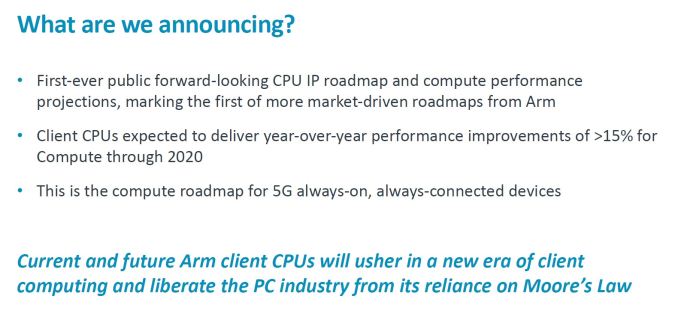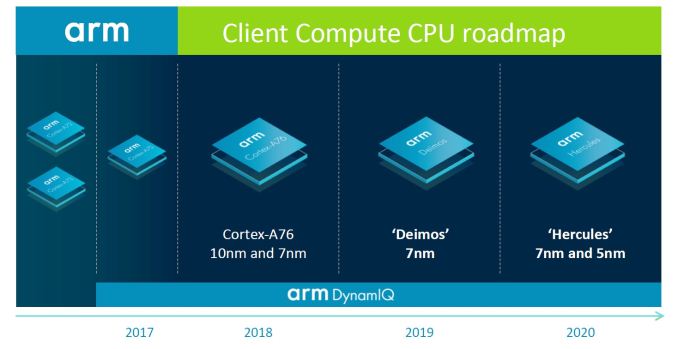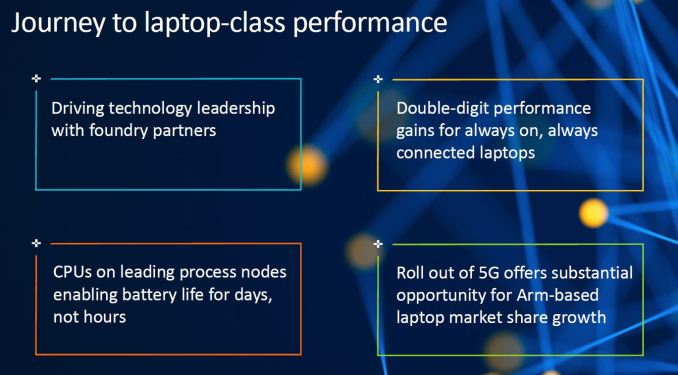Arm Unveils Client CPU Performance Roadmap Through 2020 - Taking Intel Head On
by Andrei Frumusanu on August 16, 2018 9:05 AM EST
Today’s announcement is an oddball one for Arm as we see the first-ever public forward looking CPU IP roadmap detailing performance and power projections for the next two generations through to 2020.
Back in May we extensively covered Arm’s next generation Cortex A76 CPU IP and how it’s meant to be a game-changer in terms of providing one of the biggest generational performance jumps in the company’s recent history. The narrative in particular focused on how the A76 now brought real competition and viable alternatives to the x86 market and in particular how it would be able to offer performance equivalent to Intel’s best mobile offerings, at much lower power.
Arm sees always-connected devices with 5G connectivity as a prime opportunity for a shift in the laptop market. Qualcomm’s recent Snapdragon 835 and Snapdragon 850 platforms were the first attempts in trying to establish this new slice for Arm-based PCs.
Today’s roadmap now publicly discloses the codenames of the next two generations of CPU cores following the A76 – Deimos and Hercules. Both future cores are based on the new A76 micro-architecture and will introduce respective evolutionary refinements and incremental updates for the Austin cores.
The A76 being a 2018 product – and we should be hearing more on the first commercial devices on 7nm towards the end of the year and coming months, Deimos is its 2019 successor aiming at more wide-spread 7nm adoption. Hercules is said to be the next iteration of the microarchitecture for 2020 products and the first 5nm implementations. This is as far as Arm is willing to project in the future for today’s disclosure, as the Sophia team is working on the next big microarchitecture push, which I suspect will be the successor to Hercules in 2021.
Part of today’s announcement is Arm’s reiteration of the performance and power goals of the A76 against competing platforms from Intel. The measurement metric today was the performance of a SPECint2006 Speed run under Linux while complied under GCC7. The power metrics represent the whole SoC “TDP”, meaning CPU, interconnect and memory controllers – essentially the active platform power much in a similar way we’ve been representing smartphone mobile power in recent mobile deep-dive articles.
Here a Cortex A76 based system running at up to 3GHz is said to match the single-thread performance of an Intel Core i5-7300U running at its maximum 3.5GHz turbo operating speed, all while doing it within a TDP of less than 5W, versus “15W” for the Intel system. I’m not too happy with the power presentation done here by Arm as we kind of have an apples-and-oranges comparison; the Arm estimates here are meant to represent actual power consumption under the single-threaded SPEC workload while the Intel figures are the official TDP figures of the SKU – which obviously don’t directly apply to this scenario.
We didn’t have internal data to verify Arm’s claims as of publishing of the article, but the 15W Intel figure is naturally on the high side, given that this just the official TDP representing multi-threaded workloads – a very quick test of CB15 ST power as reported by MSR registers on an 7200U at 3.1GHz measured 9.3W package+DRAM power while an 8250U at 3.35GHz came in at 11W. I haven’t correlated SPEC power on x86 to date, but I’m expecting it on average to be less than CB15. Even if the 15W figure for the 7300U is correct, and I’m expecting something more in the range of 9-11W, Arm might be using one of Intel’s notably less efficient performance points when doing the comparison for these SKUs. Of course this doesn’t invalidate the data as efficiency for the A76 at those frequencies would also not be optimal, it’s just something to keep in mind.
It’s also interesting to see Arm scale back on the performance comparison as they’re using a 3GHz A76 as the comparison data-point – this is in contrast to the 3.3GHz maximum 5W performance point presented during TechDay. I had tried to estimate the A76’s power in mobile form-factors based on the different metrics Arm disclosed and came at an estimated 2.3W at 3GHz. Naturally Arm says “less than 5W” and they could be erring on the safe side of not over-promising – but if it had been *that* much lower, as in my estimate, we would have maybe seen even more aggressive marketing figures. In the end, until we get the first A76 devices in our hands, we won’t know for sure what the exact figures will be and at which point on the efficiency curve Arm’s projected 3GHz performance figures will end up at.
The last slide that is notable to talk about is the performance projections for Deimos and Hercules. Here Arm’s taking a direct stab at Intel’s lack of significant progress over the last few years and reiterating its confidence in the company’s ability in sustaining high CAGR (compound annual growth rate) performance figures for the next generations.
Again at TechDay we quoted figures of 20-25% while today’s announcement contained a more conservative figures of “>=15%” – likely better representing a seemingly larger 20% projected boost for Deimos as well as what seems to be a 10% gain for the 5nm follow-up Hercules. Taking into account the relative positioning of the data-points in this chart, I did some quick correlation and it matches my initial estimated performance figures for a 3GHz A76 at around ~26 SPECint2006. Deimos and Hercules would come in at figures of ~31 and ~34 points.
Finally today’s announcement is a marketing exercise attempting to emphasise Arm’s performance and power commitments over the next few generations, trying to showcase it has the strategy and technology in place to make the Arm laptop market a real growth opportunity. If and how this pans out is something that we won’t find out at least until later on in the year, with the first actual A76 based large form-factor designs not being a thing until at least sometime in 2019. We’re eagerly awaiting the first A76 based mobile designs in the months to come and to have a first hand-on evaluation of the new microarchitecture family.















102 Comments
View All Comments
MrSpadge - Friday, August 17, 2018 - link
Not yet, but the app store makes recompilation for ARM rather easy - maybe as easy as it gets. That's one major point why it exists at all.Wilco1 - Friday, August 17, 2018 - link
And Chrome already runs on Arm in Android, so a Windows on Arm version should not be too difficult.Charbax - Sunday, August 19, 2018 - link
Google isn't eager to provide the ARM Port of Chrome for Windows on ARM, that is just Google being stupid. Most CHrome browsers run on ARM Powered devices already, there are 3 billion people using Chrome every day on ARM today. Google has Chrome ready for Windows on ARM, they are just being stupid not to yet make it available.Barilla - Thursday, August 16, 2018 - link
There's tons of people for whom the large x86 programs library is irrelevant already. I personally know people who get by with iPad, or an Android tablet as their primary "computer". And even more people who use a PC or a Mac and never use anything beyond internet browser and basic media viewing software - music, video, photo, pdf, word etc - and there are great ARM based programs to do all that.imaheadcase - Thursday, August 16, 2018 - link
That comment doesn't really matter though to massive amounts of people. What you just said is like someone saying "Well Linux can do all the things a PC does". Which if you ask a regular person what linux is they would go "Isn't that like a cat?". In the world of Electronics it doesn't matter if you have the best product on market, it matters how you market a product.Barilla - Thursday, August 16, 2018 - link
I'm not sure how that invalidates what I said. People don't care (or more precisely, mostly don't even know) what CPU architecture they are running. So if ARM can offer a CPU that can run as fast as Intel and offer them twice the battery life, they'll be happy to use it.wumpus - Thursday, August 16, 2018 - link
The other issue is that plenty of people are equally clueless about what Windows is, and probably mistake it for Chrome or Firefox that they need to get to Facebook, email, and other social media.I know my mother went through this huge hassle about buying a "windows 10 compatible notebook", only to later find out what she really wanted was something just like my Aunt's Chromebook. On the other hand, my dad has a few windows applications (mostly Family Tree Maker) that it is impossible to pry him off windows.
melgross - Friday, August 17, 2018 - link
True. But Apple is selling 60 million iPads a year, and sales have again been rising, though slowly.And Linux is stuck in never never land. All the major OSs, Android, iOS, macOS and Windows are far more accessible than Linux, with all of its improvements over the years. There’s a reason why it still averages just a 1.5% marketshare over the years.
bug77 - Thursday, August 16, 2018 - link
Cross compiling has come a long way ;)HStewart - Thursday, August 16, 2018 - link
As a developer for around 32 years and 22 years with same x86 application, cross compiling is not always possible in real world applications - in the professional world, application can struggle even to run across different version of Windows OS's if not CPU designs.This does include the folks that like playing Older games which line could be stop by developer - for example a lot EA games which pretty much EA has destroy in newer games - or stop release - the game that comes to mind is the Command and Conquer series which played since the original.
Also keep in mind Linux market is extremely small.